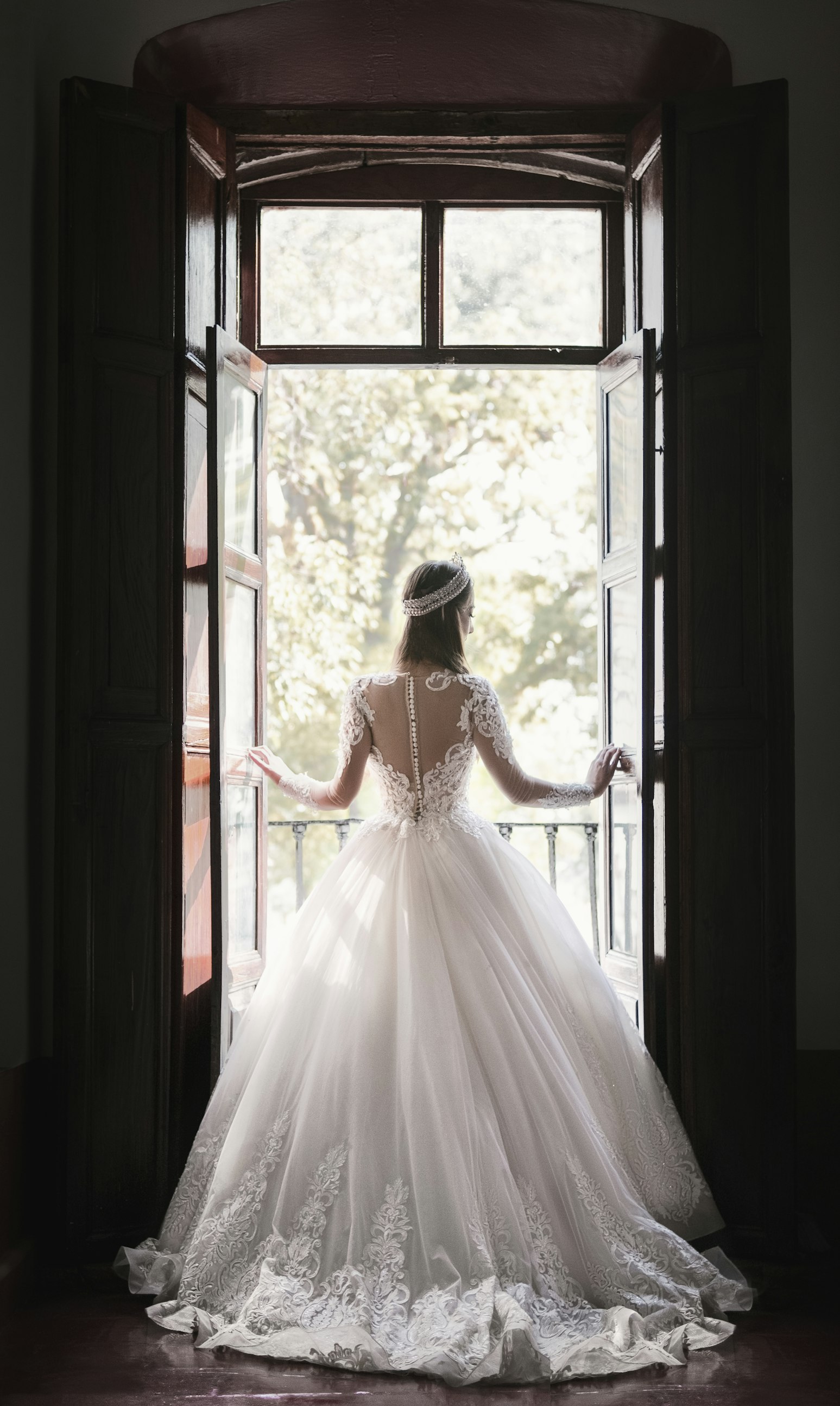For a wedding day to be truly unforgettable, the bride’s choice of bridal gown is crucial. Dresses for weddings are selected with care to exude beauty, elegance, and timelessness. From classic whites to beautiful ivories, wedding dresses are picked to reflect beauty, elegance, and timelessness.
Unfortunately, the passage of time may be a tough adversary for even the whitest of dresses, since it can cause them to fade to a yellowish hue. Many future brides have wondered how long it takes for their wedding gown to turn yellow because of this phenomenon.

This article takes you on a journey to learn what causes wedding dresses to yellow and how you may prevent that from happening to your dress.
This article will explain the fascinating phenomenon of a wedding dress’s transformation and give you tips on how to keep your gown looking beautiful for generations to come, whether you’re a bride-to-be, a lover of vintage clothing, or just someone interested in the science behind fabric discolouration.
Come with me as we explore the intriguing world of bridal fashion and get the answer to the age-old question: how long does it take for a wedding dress to become yellow?
How Long Before Wedding Dress Turns Yellow?
The time it takes for a wedding gown to become yellow varies greatly based on several factors. Here are some of the most important causes of a wedding dress turning yellow and how long it takes:
- Fabric Type: The type of fabric used in the wedding dress plays a crucial role in determining how quickly it yellows. Natural fibres like silk and cotton are more prone to yellowing over time compared to synthetic fabrics like polyester. Silk, for instance, can yellow relatively quickly if not properly stored.
- Exposure to Light: Exposure to natural or artificial light, especially ultraviolet (UV) light, can accelerate the yellowing process. If your wedding dress is displayed in a well-lit area or exposed to sunlight, it may yellow more rapidly.
- Storage Conditions: The way you store your wedding dress after the wedding is essential. Proper storage in a cool, dark, and dry environment with minimal humidity can significantly delay yellowing. Wedding dresses stored in damp or humid conditions are more likely to yellow faster.
- Environmental Factors: Environmental factors, such as air pollution and the quality of the air in the storage area, can also influence how quickly a wedding dress yellows.
- Cleaning and Preservation: Having your wedding dress professionally cleaned and preserved shortly after your wedding can help slow down the yellowing process. Preservation specialists are trained to remove stains and contaminants that can contribute to discolouration.
- Fabric Treatments: Some wedding dresses are treated with chemicals or finishes that can make them more resistant to yellowing. However, these treatments may wear off over time.
- Wear and Tear: The more a wedding dress is worn, handled, or exposed to various elements, the greater the likelihood of yellowing. Dresses that have been worn multiple times or not properly cleaned and stored may yellow faster.
It is difficult to give an exact timeline for when a wedding dress may turn yellow due to the many factors involved. The length of time your dress retains its beautiful state depends on how well you care for it, from how often you wear it to how you store it. It’s fairly uncommon for wedding dresses that have been carefully stored to retain their original colour for decades.
How Do You Store A Dress So It Doesn’t Yellow?
Attention to detail is one of the most important aspects of paraphrasing. Maintaining your garment in excellent condition for as long as possible is possible with the right storage conditions. So, how to keep wedding dress from yellowing?:
Clean the Dress:
Before storing your dress, have it professionally cleaned by a reputable bridal gown cleaner. Make sure to choose a cleaner with experience in wedding dress preservation. Cleaning removes any stains, oils, or residues that can contribute to yellowing over time.
Choose an Appropriate Storage Location:
- Cool and Dark: Select a storage area that is cool, dark, and away from direct sunlight. Exposure to light, especially UV light, can accelerate yellowing.
- Stable Temperature and Humidity: Aim for a stable temperature and humidity level. Fluctuations in temperature and humidity can promote moisture buildup and mould growth.
- Ventilation: Ensure proper ventilation to prevent musty odours and moisture accumulation.
Use a Breathable Garment Bag or Box:
- Breathable Material: Avoid plastic garment bags, as they can trap moisture and promote yellowing. Instead, opt for a breathable, acid-free garment bag or acid-free wedding dress storage box.
- Acid-Free Tissue Paper: Place acid-free tissue paper between the folds of the dress to prevent creasing and minimize contact between layers.
Hang the Dress Properly:
- Use a padded hanger to support the dress’s weight, avoiding distortion of the shoulders.
- Avoid hanging the dress by its straps or any delicate embellishments, as they can stretch or tear over time.
Protect Against Dust and Pests:
- Zip or seal the garment bag or box securely to keep out dust and pests.
- Consider adding mothballs or cedar blocks to deter insects if your storage area is prone to infestations.
Inspect Periodically:
Regularly inspect your stored dress to ensure there are no signs of yellowing, mould, or damage. If you notice any issues, take appropriate action promptly.
Avoid Long-Term Storage:
While wedding dresses can be stored for years, it’s best not to store them for excessively long periods. If you plan to store your dress for an extended period, consider consulting a preservation specialist for guidance on maintaining its condition.
Handle with Clean Hands:
If you need to touch the dress while inspecting or moving it, make sure your hands are clean to prevent transferring oils and dirt onto the fabric.
Avoid DIY Preservation:
DIY preservation kits are available, but for valuable and delicate wedding dresses, it’s often recommended to entrust the preservation process to a professional.
Document and Maintain Records:
Keep records of your dress, including photographs, receipts, and any preservation certificates. This documentation can be helpful for insurance purposes or future reference.
If you want your wedding dress to look its best for years to come, you can reduce the chance of yellowing or other damage by following these procedures and maintaining perfect storage conditions.
Conclusion
It is just as important to take care of your wedding dress after the big day as it is to wear it for the first time so that it retains its perfect beauty. You may extend the life of your gown and prevent it from gradually turning a shade of yellow by sticking to precise cleaning practices, appropriate storage conditions, and frequent maintenance practices.
Your wedding dress is more than simply an article of clothing; it is a beloved keepsake that carries memories of the most important day of your life. It can continue to be a symbol of love and passion for many years to come, serving as a constant reminder of the happiness and enchantment that surrounded your wedding day.
Consequently, it is important to dedicate some of your time and energy to the task of conserving this priceless piece, and you should do so so that your dress can continue to sparkle just as brightly as your relationship.
